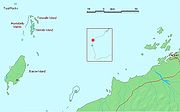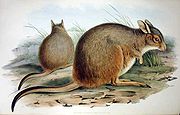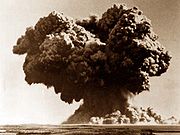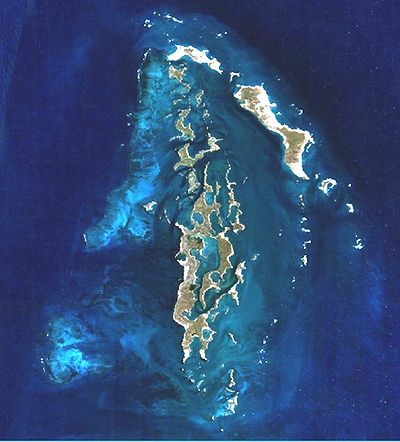
Montebello Islands
Encyclopedia




Archipelago
An archipelago , sometimes called an island group, is a chain or cluster of islands. The word archipelago is derived from the Greek ἄρχι- – arkhi- and πέλαγος – pélagos through the Italian arcipelago...
of around 174 small islands (about 92 of which are named) lying 20 kilometres (12 mi) north of Barrow Island
Barrow Island (Western Australia)
Barrow Island is a island located northwest off the coast of Western Australia. The island is the second largest in Western Australia after Dirk Hartog Island.-Discovery and early history:...
and 130 kilometres (81 mi) off the Pilbara
Pilbara region of Western Australia
The Pilbara is a large, dry, thinly populated region in the north of Western Australia known for its vast mineral deposits, in particular iron ore...
coast of north-western Australia
Australia
Australia , officially the Commonwealth of Australia, is a country in the Southern Hemisphere comprising the mainland of the Australian continent, the island of Tasmania, and numerous smaller islands in the Indian and Pacific Oceans. It is the world's sixth-largest country by total area...
. Montebello is Italian
Italian language
Italian is a Romance language spoken mainly in Europe: Italy, Switzerland, San Marino, Vatican City, by minorities in Malta, Monaco, Croatia, Slovenia, France, Libya, Eritrea, and Somalia, and by immigrant communities in the Americas and Australia...
for "beautiful mountain". The islands form a conservation park administered by the Western Australia
Western Australia
Western Australia is a state of Australia, occupying the entire western third of the Australian continent. It is bounded by the Indian Ocean to the north and west, the Great Australian Bight and Indian Ocean to the south, the Northern Territory to the north-east and South Australia to the south-east...
n Department of Environment and Conservation
Department of Environment and Conservation
The Department of Environment and Conservation is a department of the Government of Western Australia that is responsible for implementing the state's conservation and environment legislation and regulations...
, and it is likely that the shallow waters around them will become a marine conservation reserve.
Description
The islands of the archipelago have a collective land area of about 22 km2 The largest islands, Hermite (or Hermit) and Trimouille have areas of 1022 ha and 522 ha respectively. They consist of limestoneLimestone
Limestone is a sedimentary rock composed largely of the minerals calcite and aragonite, which are different crystal forms of calcium carbonate . Many limestones are composed from skeletal fragments of marine organisms such as coral or foraminifera....
rock and sand
Sand
Sand is a naturally occurring granular material composed of finely divided rock and mineral particles.The composition of sand is highly variable, depending on the local rock sources and conditions, but the most common constituent of sand in inland continental settings and non-tropical coastal...
. The rocky parts are dominated by Triodia hummock grassland
Grassland
Grasslands are areas where the vegetation is dominated by grasses and other herbaceous plants . However, sedge and rush families can also be found. Grasslands occur naturally on all continents except Antarctica...
with scattered shrub
Shrub
A shrub or bush is distinguished from a tree by its multiple stems and shorter height, usually under 5–6 m tall. A large number of plants may become either shrubs or trees, depending on the growing conditions they experience...
s, while the sandy areas support grass
Grass
Grasses, or more technically graminoids, are monocotyledonous, usually herbaceous plants with narrow leaves growing from the base. They include the "true grasses", of the Poaceae family, as well as the sedges and the rushes . The true grasses include cereals, bamboo and the grasses of lawns ...
es, sedges
Cyperaceae
Cyperaceae are a family of monocotyledonous graminoid flowering plants known as sedges, which superficially resemble grasses or rushes. The family is large, with some 5,500 species described in about 109 genera. These species are widely distributed, with the centers of diversity for the group...
and shrubs, mainly Acacia
Acacia
Acacia is a genus of shrubs and trees belonging to the subfamily Mimosoideae of the family Fabaceae, first described in Africa by the Swedish botanist Carl Linnaeus in 1773. Many non-Australian species tend to be thorny, whereas the majority of Australian acacias are not...
. Patches of mangrove
Mangrove
Mangroves are various kinds of trees up to medium height and shrubs that grow in saline coastal sediment habitats in the tropics and subtropics – mainly between latitudes N and S...
s grow in sheltered bays and channels of the archipelago, especially at Hermite Island. The climate is hot and arid
Desert climate
A desert climate , also known as an arid climate, is a climate that does not meet the criteria to be classified as a polar climate, and in which precipitation is too low to sustain any vegetation at all, or at most a very scanty scrub.An area that features this climate usually experiences less than...
with an annual average rainfall of about 320 mm.
Birds
The islands have been identified by BirdLife InternationalBirdLife International
BirdLife International is a global Partnership of conservation organisations that strives to conserve birds, their habitats and global biodiversity, working with people towards sustainability in the use of natural resources...
as an Important Bird Area
Important Bird Area
An Important Bird Area is an area recognized as being globally important habitat for the conservation of bird populations. Currently there are about 10,000 IBAs worldwide. The program was developed and sites are identified by BirdLife International...
(IBA) because they support over 1% of the world populations of Fairy
Fairy Tern
The Fairy Tern is a small tern which occurs in the southwestern Pacific.There are three subspecies:* Australian Fairy Tern, Sterna nereis nereis - breeds in Australia...
and Roseate Tern
Roseate Tern
The Roseate Tern is a seabird of the tern family Sternidae. This bird has a number of geographical races, differing mainly in bill colour and minor plumage details....
s, and of Sooty Oystercatcher
Sooty Oystercatcher
The Sooty Oystercatcher, Haematopus fuliginosus, is a species of oystercatcher. It is a wading bird native to Australia and commonly found on its coastline. It prefers rocky coastlines, but will occasionally live in estuaries....
s. Greater Crested Tern
Greater Crested Tern
The Greater Crested Tern , also called Crested Tern or Swift Tern, is a seabird in the tern family which nests in dense colonies on coastlines and islands in the tropical and subtropical Old World...
s breed there irregularly, sometimes in large numbers. Other birds breeding on the islands include Osprey
Osprey
The Osprey , sometimes known as the sea hawk or fish eagle, is a diurnal, fish-eating bird of prey. It is a large raptor, reaching more than in length and across the wings...
s, White-bellied Sea-Eagles, Pied Oystercatcher
Pied Oystercatcher
The Pied Oystercatcher, Haematopus longirostris, is a species of oystercatcher. It is a wading bird native to Australia and commonly found on its coastline. The similar South Island Pied Oystercatcher The Pied Oystercatcher, Haematopus longirostris, is a species of oystercatcher. It is a wading...
s, Caspian Tern
Caspian Tern
The Caspian Tern is a species of tern, with a subcosmopolitan but scattered distribution. Despite its extensive range, it is monotypic of its genus, and has no subspecies accepted either...
s and Bridled Tern
Bridled Tern
The Bridled Tern is a seabird of the tern family Sternidae. It is a bird of the tropical oceans.-Description:...
s. The islands support 12-15 breeding pairs of Beach Stone-curlew
Beach Stone-curlew
The Beach Stone-curlew, Esacus giganteus also known as Beach Thick-knee is a large, ground-dwelling bird that occurs in Australasia, the islands of South-east Asia...
s. Yellow White-eye
Yellow White-eye
The Canary White-eye or Yellow White-eye is a species of bird in the Zosteropidae family endemic to Australia.Its natural habitat is subtropical or tropical mangrove forests.-References:...
s have been recorded.
Mammals
InvasiveInvasive species
"Invasive species", or invasive exotics, is a nomenclature term and categorization phrase used for flora and fauna, and for specific restoration-preservation processes in native habitats, with several definitions....
Feral cat
Feral cat
A feral cat is a descendant of a domesticated cat that has returned to the wild. It is distinguished from a stray cat, which is a pet cat that has been lost or abandoned, while feral cats are born in the wild; the offspring of a stray cat can be considered feral if born in the wild.In many parts of...
s and Black Rat
Black Rat
The black rat is a common long-tailed rodent of the genus Rattus in the subfamily Murinae . The species originated in tropical Asia and spread through the Near East in Roman times before reaching Europe by the 1st century and spreading with Europeans across the world.-Taxonomy:The black rat was...
s have been eradicated from the islands. Mala
Rufous Hare-wallaby
The rufous hare-wallaby , also known as the Mala, is a small macropod found in Australia. It was formerly widely distributed across the western half of the continent but is now confined to Bernier Island and Dorre Island Islands off Western Australia...
and Djoongari
Shark Bay Mouse
The Shark Bay Mouse, Djoongari or Alice Springs Mouse is a species of rodent in the family Muridae. It is found only in Australia, restricted to four islands in the Shark Bay area. It was once found throughout the western two thirds of Australia but it suffered greatly after the arrival of...
have been translocated to the islands under the conservation management strategy for these threatened species.
History
The two main islands were discovered by the FrenchFrance
The French Republic , The French Republic , The French Republic , (commonly known as France , is a unitary semi-presidential republic in Western Europe with several overseas territories and islands located on other continents and in the Indian, Pacific, and Atlantic oceans. Metropolitan France...
explorer Nicolas Baudin
Nicolas Baudin
Nicolas-Thomas Baudin was a French explorer, cartographer, naturalist and hydrographer.Baudin was born a commoner in Saint-Martin-de-Ré on the Île de Ré. At the age of fifteen he joined the merchant navy, and at twenty joined the French East India Company...
in 1801. Hermite Island is named after the French Admiral Jean-Marthe-Adrien L'Hermite
Jean-Marthe-Adrien l'Hermite
Jean-Marthe-Adrien L'Hermitte was a French sea captain and rear admiral, notable for his involvement in the Glorious First of June and various other campaigns.- Early career :L'Hermitte was born to the family of a...
. Trimouille Island is named after a French noble family. There are problems with the naming of the islands in the accounts of the early explorers, and it has been suggested that the French. and later the British, explorers mixed up the names of Lowendal and Hermite Islands.
An early reference to the islands is in 1622, when the Tryall
Tryall
The Tryall was a British East India Company owned East Indiaman of approximately 500 tons. She was under the command of John Brooke when she was wrecked on the Tryal Rocks off the north-west coast of Western Australia in 1622...
was wrecked just west of them. For years afterwards their approximate position was recorded on charts as the Tryal Rocks
Tryal Rocks
Tryal Rocks, sometimes spelled Trial Rocks or Tryall Rocks, formerly known as Ritchie's Reef or the Greyhound's Shoal, is a reef of rock located in the Indian Ocean off the northwest coast of Australia, about 16 kilometres northwest of the outer edge of the Montebello Islands group...
. The islands were economically significant for pearl fishing from the end of the nineteenth century until the outbreak of the Second World War.
Operation Hurricane
A bay of Trimouille Island was the site of Operation Hurricane, the first British nuclear weaponNuclear weapons and the United Kingdom
The United Kingdom was the third country to test an independently developed nuclear weapon, in October 1952. It is one of the five "Nuclear Weapons States" under the Nuclear Non-Proliferation Treaty, which the UK ratified in 1968...
s test on 3 October 1952. There were two further tests on Alpha and Trimouille Islands in 1956. The second of these, codenamed G2, was the largest device ever detonated in Australia, with a yield of 98 kt. Queensland towns such as Mount Isa, Julia Creek, Longreach and Rockhampton were contaminated by the fallout from the test.
Islands
Of the smaller islands, the largest are:- North-West Island
- Primrose Island
- Bluebell Island
- Alpha Island
- Crocus Island
- Campbell Island
- Delta Island
- Renewal Island
- Ah Chong Island
There are also 10 named groups of small islets, whose individual islands have not yet been named:
- Corkwood Islands
- Fig Islands
- Hakea Islands
- Jarrah Islands
- Jasmine Islands
- Karri Islands
- Marri Islands
- Minnieritchie Islands
- Mulga Islands
- Quandong Islands

Further reading
- Acaster, Ray. (1995). British nuclear testing at the Monte Bello Islands. Early Days Vol. 11, no.1. pp.66-80.
- Arnold, Lorna; and Smith, Mark. (2006). Britain, Australia and the BombBritain, Australia and the BombBritain, Australia and the Bomb: the Nuclear Tests and Their Aftermath is a 2006 book by Lorna Arnold and Mark Smith. It is the second edition of an official history first published in 1987 by HMSO under another title: A Very Special Relationship: British Atomic Weapons Trials in Australia...
: The Nuclear Tests and their Aftermath. Palgrave MacMillan. ISBN 1403921024 - Bird, Peter. (1989). Operation Hurricane. Square One Publications: Worcester. (First published in 1953). ISBN 187201710X
- Burbidge, A. A. (1971). The fauna and flora of the Monte Bello Islands. Department of Fisheries and Fauna: Perth.
- Deegan, P. M. (1992). Monte Bello and Lowendal Islands: bibliography, summary report of marine resources. Dept. of Conservation and Land Management: Perth.
- Duyker, EdwardEdward DuykerEdward Duyker is an Australian historian and author born in Melbourne, Victoria, to a father from the Netherlands and a mother from Mauritius...
. (2006). François Péron: An Impetuous Life: Naturalist and Voyager. Miegunyah/MUP: Melbourne. ISBN 978-0522-85260-8 - Fornasiero, Jean; Monteath, Peter; and West-Sooby, John. (2004). Encountering Terra Australis: the Australian voyages of Nicholas Baudin and Matthew Flinders. Wakefield Press: Kent Town, South Australia. ISBN 1-86254-625-8
- Horner, Frank. (1987). The French Reconnaissance: Baudin in Australia 1801—1803. Melbourne University Press: Melbourne. ISBN 0522843395.
- Tuckfield, Trevor. (1 August 1951). The Monte Bello Islands. Walkabout, Vol. 17, No. 8. pp.33-34.
External links
- Video footage of the Operation Hurricane detonation on Trimouille Island in 1951
- Nicolas Baudin’s Scientific Expedition To The Terres Australes by Steve Reynolds - Marine Life Society of South Australia Inc.
- Details of a feral cat eradication program on Hermite Island in 1999
- Nuclear testing details

